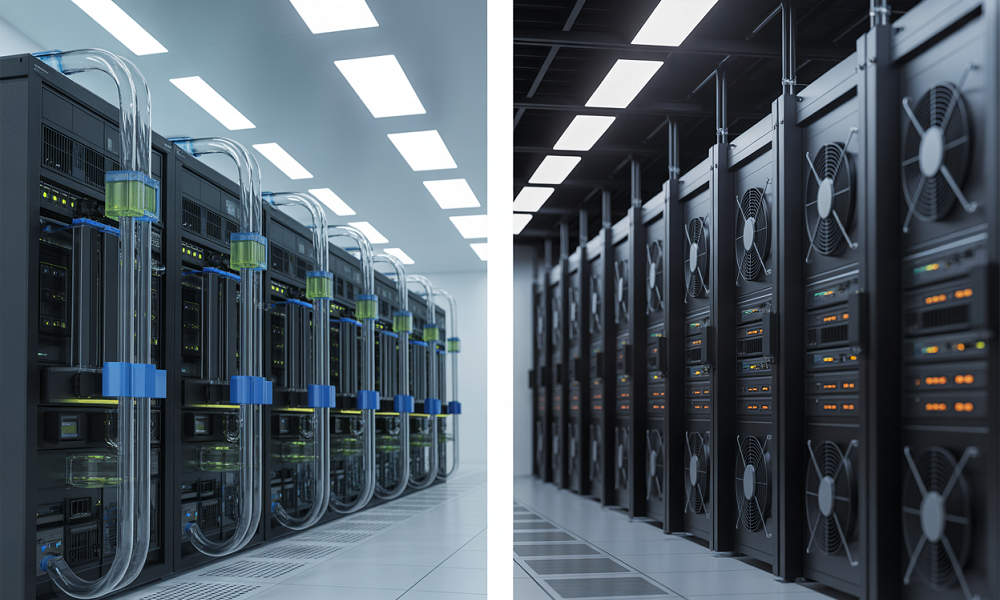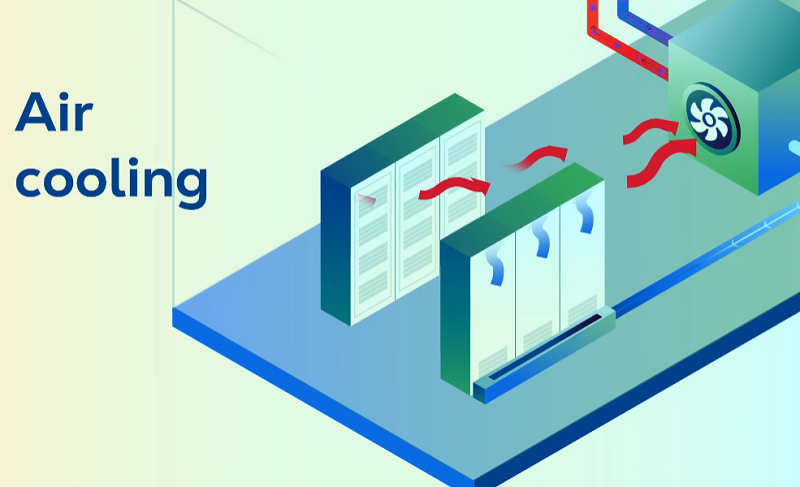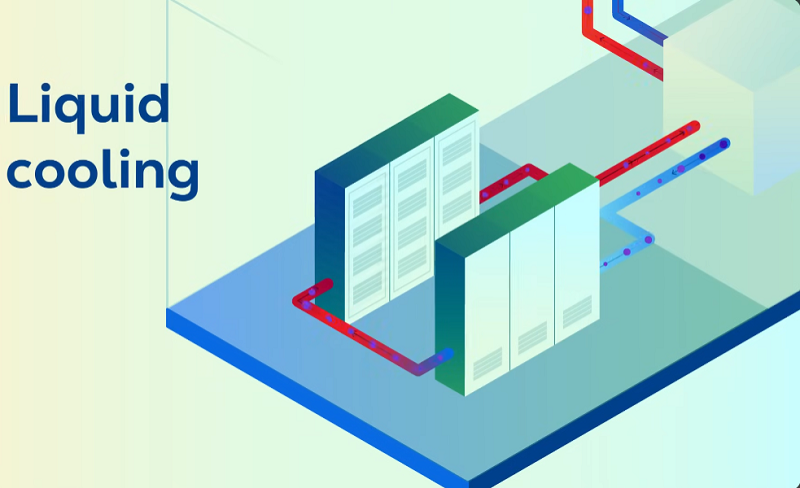NEWS TAG
brand
Liquid Cooling vs Air Cooling Data Center: Pros, Cons, Cost & Which Is Better?
As digital services expand, data centers have become the key engine for everything from streaming to powering advanced artificial intelligence. This rapid growth in computing power brings an inevitable byproduct: heat. Traditionally, air cooling has been the standard for keeping servers at optimal temperatures. But as hardware density and energy demands climb, air cooling methods are struggling to keep up, leading to higher energy use and increasing operational challenges. This has opened the way for liquid cooling, a technology that promises greater thermal efficiency, higher computing density, and a more sustainable path forward. Choosing the right cooling strategy is now one of the most important decisions for any data center project.

What is Air Cooling Data Center?
Air cooling data centers rely on air conditioning, fans, and airflow management to move hot air out of the server racks and bring in cool air. This is the traditional method, familiar to anyone who has heard the whir of fans in a desktop or laptop when under load. In large-scale facilities, air cooling can involve complex arrangements of cold aisles, hot aisles, and raised floors to optimize airflow.
Modern air-cooled systems may include advanced features like closed-loop airflow cabinets, high-efficiency heat exchangers, and dynamic controls that adjust fan speeds based on server load. Air cooling technology is well-understood, straightforward to manage, and less costly to install and maintain. It is generally preferred where heat densities are moderate and simplicity, reliability, and cost predictability are priorities.

What is Liquid Cooling Data Center?
Liquid cooling data centers use fluids, such as water or specialized coolants, to absorb and carry away heat directly from IT equipment. There are two main approaches:
Direct-to-Chip Cooling: Here, coolant flows directly over processors, memory modules, and sometimes GPUs, removing heat at its source. This enables servers to operate at higher performance levels without sacrificing density or needing to remove drives to optimize airflow.
Immersion Cooling: In this method, entire servers are submerged in non-conductive, dielectric fluids. The liquid absorbs heat generated by all components, and then circulates it away via heat exchangers. Immersion cooling allows for even greater efficiency and reduced energy usage compared to traditional air systems.
Both methods enable data centers to pack more computing hardware into the same footprint, enhance performance, and reduce long-term operational costs. For example, a high-density server with direct liquid cooling can handle powerful CPUs and GPUs with less reliance on fans, allowing more NVMe drives and higher efficiency. Immersion cooling, especially, stands out for its ability to cool hardware nearly silently and with minimal waste.

Liquid Cooling vs Air Cooling Data Center: Pros and Cons
Air Cooling:
For 40 years, data centers have been built with the same infrastructure, utilizing AIR, AIR, and more AIR, which requires deployment & maintenance of obsolete infrastructure such as raised floors, CRAC units, and more. The following advantages have made it the preferred choice for data centers for many years, but it also has increasing limitations as technology advances:
Pros:
Lower initial costs for installation and equipment.
Well-understood by data center staff, reducing the learning curve.
Easier to maintain and operate, with standard components and processes.
Simpler to retrofit into existing facilities.
Cons:
Struggles with high-density deployments and powerful GPUs.
Less energy efficient; CRAC units account for 90% of the energy used to cool this space, higher operational costs as server loads increase.
Larger physical footprint required for the same compute power.
Greater reliance on air conditioning and fans, leading to more noise and potential hot spots.
Liquid Cooling Pros & Cons:
In recent years, liquid cooling has gradually begun to replace air cooling systems in some large data centers because of its following advantages:
Pros:
Handles higher heat densities, enabling denser server deployments.
Removes heat more efficiently, liquid conducts thousands of times more heat than air.
Reduces overall energy consumption, up to 50% power savings than air cooling, contributing to sustainability goals.
Enables quieter operation and can extend hardware life by keeping components at more stable temperatures.
Minimizes the need for water-intensive chillers, especially in closed-loop designs.
Fewer UPS, no raised floor, samller switchgear, minim 60% space savings
Ideal for high-performance computing, AI, and workloads with heavy GPU use.
Cons:
Higher upfront investment for installation and specialized equipment.
Maintenance requires skilled personnel with experience in fluid management and leak prevention.
Upgrading existing air-cooled facilities to liquid cooling can be costly, involving major changes to infrastructure such as adding large water pipes or coolant delivery systems.
Requires robust risk management to address leaks and material compatibility issues.
Liquid Cooling vs Air Cooling Data Center: Cost
Cost is a deciding factor for many organizations. Liquid cooling systems come with higher upfront costs due to specialized equipment and installation. Modifying an existing air-cooled facility to support liquid cooling can involve extensive plumbing work and risk management measures, making upgrades a major investment.
However, liquid cooling can reduce long-term operational expenses. It achieves this by lowering energy consumption (sometimes by up to 80%) and cutting costs associated with water-intensive chillers. Over a 10-year period, energy savings and improved hardware reliability can offset the initial investment, offering a favorable return on investment for high-density environments.
Air cooling remains less expensive to set up and maintain in the short term, making it a practical choice for smaller or more traditional data centers. But in the long run, particularly where high performance and efficiency are required, the operational costs of running and maintaining air cooling systems can outweigh the initial savings.
The right approach depends on the scale of your facility, your energy costs, and your long-term goals. A detailed cost-benefit analysis tailored to your situation is necessary to make the best choice.
Liquid Cooling vs Air Cooling Data Center: Which Is Better For Your Project?
| Feature | Liquid Cooling | Air Cooling |
|---|---|---|
| Typical Equipment & Structures | Direct-to-Chip: Cold plates on CPUs/GPUs, coolant distribution units (CDUs), pumps, heat exchangers, piping, sensors, leak detection, sometimes specialized racks. Immersion: Tanks for submersion, dielectric fluid, fluid circulation pumps, heat exchangers, filtration, modified server chassis/boards. Facility Level: Chilled water loops, large-diameter piping, redundant pumps, fluid monitoring/control, integration with building management. | Rack/Server Level: High-efficiency fans, traditional heatsinks, airflow baffles, hot aisle/cold aisle containment, perforated tiles (raised floors). Room/Facility Level: Computer Room Air Conditioning (CRAC) units, Computer Room Air Handlers (CRAH), ductwork, chillers, evaporative coolers (if used), building HVAC. Monitoring: Temperature and airflow sensors, power/fan control infrastructure. |
| Cooling Efficiency | Highly efficient; handles higher heat densities; supports high-density and AI workloads | Less efficient; struggles with dense racks and high-performance hardware |
| Power Consumption | Lower energy usage; can reduce power needs by up to 80% in some applications | Higher ongoing energy consumption, especially as density increases |
| Scalability | Allows higher computing density in the same space; supports growth without expanding footprint | Limited by airflow and heat capacity; may require reducing density or performance |
| Noise Level | Quieter operation due to reduced reliance on fans | Can be noisy, especially at high loads due to large fan systems |
| Water Use | Can minimize water use and eliminate water-intensive chillers, depending on design | Typically does not use water at the server level; building-level evaporative cooling may use water |
| Upfront Cost | Higher initial investment for equipment and installation | Lower initial cost; simpler to set up and expand |
| Operational Cost | Lower long-term costs due to energy savings and improved hardware longevity | Higher over time due to increased energy use and potential for hardware stress |
| Maintenance | Requires specialized knowledge; risk management for leaks and compatibility | Well-understood; easier for most staff; fewer risks with leaks |
| Suitability | Ideal for AI, HPC, and high-density data centers; new builds can integrate easily | Suitable for traditional workloads and moderate-density environments |
| Retrofit Difficulty | Major infrastructure changes needed to upgrade existing air-cooled facilities | Simple to expand or modify within existing infrastructure |
| Reliability | Improved component reliability and lifespan through stable temperatures | Can lead to thermal stress and reduced hardware longevity if overloaded |
| Sustainability | Supports sustainability goals; reduces energy and, in some designs, water use | Increased energy use can make sustainability targets harder to meet |
Choosing between liquid and air cooling should start with a thorough analysis of your data center’s needs. Consider the following:
Heat Load: If your servers generate high heat densities, such as in AI, machine learning, or large-scale cloud environments, liquid cooling may be the better choice.
Performance Goals: Liquid cooling supports higher computing density, allowing you to do more in the same space.
Sustainability and Efficiency: Liquid cooling can help meet sustainability targets by reducing power and water use.
Budget and Infrastructure: For existing facilities, retrofitting for liquid cooling can be costly and disruptive. New builds can incorporate liquid cooling from the start for greater flexibility.
Operational Expertise: Air cooling is easier to manage with existing staff, while liquid cooling requires specialized knowledge.
If your data center handles moderate workloads and simplicity is a priority, air cooling may still be suitable. For organizations looking to scale, support advanced workloads, or meet aggressive sustainability goals, investing in liquid cooling can deliver long-term benefits.
Liquid Cooling vs Air Cooling System: Which is Better for AI Data Center?
AI workloads push data center hardware to its limits, with high-performance GPUs generating massive heat output. Traditional air cooling methods are increasingly unable to manage these loads efficiently, leading to performance throttling or the need to reduce server density.
Liquid cooling, especially direct-to-chip and immersion systems, is well-suited for AI data centers. The superior heat transfer capabilities of liquid allow for higher power densities, ensuring that even the most demanding AI applications can run at full performance. Liquid cooling also reduces the energy needed for cooling, supports the deployment of denser server racks, and enables better use of valuable floor space.
In AI-focused facilities, liquid cooling is emerging as the preferred choice, providing a path to higher performance, sustainability, and efficiency. As AI adoption grows, expect to see even more data centers transitioning to liquid cooling designs.
